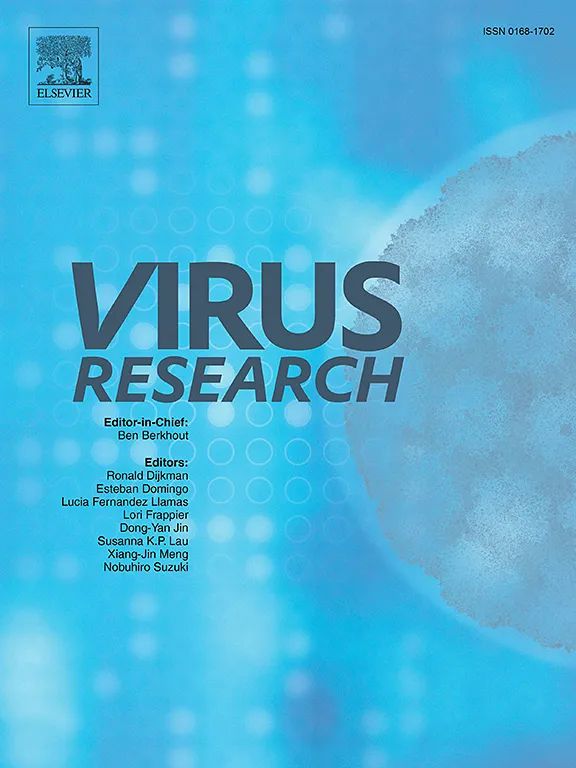Characterization of antigenically dominant regions in the hemagglutinin protein of B/victoria-lineage influenza B virus using monoclonal antibody escape mutants
IF 2.7
4区 医学
Q3 VIROLOGY
引用次数: 0
Abstract
As of 2024, B/Victoria-lineage strains have emerged as the predominant influenza B viruses globally. To elucidate the antigenic regions responsible for variation within this lineage, three monoclonal antibodies (MAbs) targeting the hemagglutinin (HA) protein were employed to generate escape mutants of the B/Victoria strain B/Aichi/20/99, which was isolated approximately 10 years after the B/Victoria and B/Yamagata lineages began cocirculating. A total of 45 escape mutants were obtained. Sequencing of their HA genes identified six amino acid substitutions at four sites within two key antigenic regions—the 160-loop and 190-helix—specifically, N165Y, N165S, K167R, and an asparagine insertion between residues 164 and 165 in the 160-loop; and K203R and K203N in the 190-helix (numbering is based on the B/Brisbane/60/2008 HA sequence). Hemagglutination inhibition (HI) assays revealed that two MAbs affected binding of both mutants with mutations in the 160-loop and those with a mutation at residue 203. Mutations in the 160-loop did not affect reactivity with antiserum against the parental B/Aichi/20/99 strain, whereas K203N substitution reduced antiserum reactivity, indicating the antigenic importance of this residue. Further HI analyses using eight B/Victoria lineage strains isolated between 1997 and 2021 showed that all three MAbs lost reactivity with strains isolated after 2016, while the antiserum demonstrated reduced reactivity. Notably, the current vaccine strain, B/Austria/1359417/2021, which harbors substitutions at positions 150 and 203, also exhibited diminished reactivity. These findings suggest that both the 150-loop and 190-helix constitute antigenically dominant sites that contribute to immune escape and the emergence of drift variants within the B/Victoria-lineage.
利用单克隆抗体逃逸突变体研究B/维多利亚乙型流感病毒血凝素蛋白抗原优势区
截至2024年,B/维多利亚谱系毒株已成为全球主要的乙型流感病毒。为了阐明该谱系变异的抗原区域,利用3种靶向血凝素(HA)蛋白的单克隆抗体(mab)产生B/Victoria菌株B/Aichi/20/99的逃逸突变体,该突变体是在B/Victoria和B/Yamagata谱系开始共循环约10年后分离出来的。共获得45个逃逸突变体。他们的HA基因测序在两个关键抗原区域(160环和190螺旋)的四个位点上发现了六个氨基酸替换,特别是N165Y, N165S, K167R,以及160环中164和165残基之间的天冬酰胺插入;和K203R和K203N在190螺旋(编号基于B/Brisbane/60/2008 HA序列)。血球凝集抑制(HI)实验显示,两种单克隆抗体影响了160环突变体和203环突变体的结合。160环突变不影响抗血清对亲本B/爱知/20/99菌株的反应性,而K203N取代降低了抗血清反应性,表明该残基具有重要的抗原性。对1997年至2021年间分离的8株B/Victoria谱系菌株进行的进一步HI分析显示,所有3种单克隆抗体与2016年之后分离的菌株都失去了反应性,而抗血清的反应性降低。值得注意的是,目前的疫苗株B/Austria/1359417/2021在150和203位上有取代,反应性也有所下降。这些发现表明,在B/维多利亚谱系中,150环和190螺旋构成抗原优势位点,有助于免疫逃逸和漂移变异的出现。
本文章由计算机程序翻译,如有差异,请以英文原文为准。
求助全文
约1分钟内获得全文
求助全文
来源期刊

Virus research
医学-病毒学
CiteScore
9.50
自引率
2.00%
发文量
239
审稿时长
43 days
期刊介绍:
Virus Research provides a means of fast publication for original papers on fundamental research in virology. Contributions on new developments concerning virus structure, replication, pathogenesis and evolution are encouraged. These include reports describing virus morphology, the function and antigenic analysis of virus structural components, virus genome structure and expression, analysis on virus replication processes, virus evolution in connection with antiviral interventions, effects of viruses on their host cells, particularly on the immune system, and the pathogenesis of virus infections, including oncogene activation and transduction.
 求助内容:
求助内容: 应助结果提醒方式:
应助结果提醒方式:


